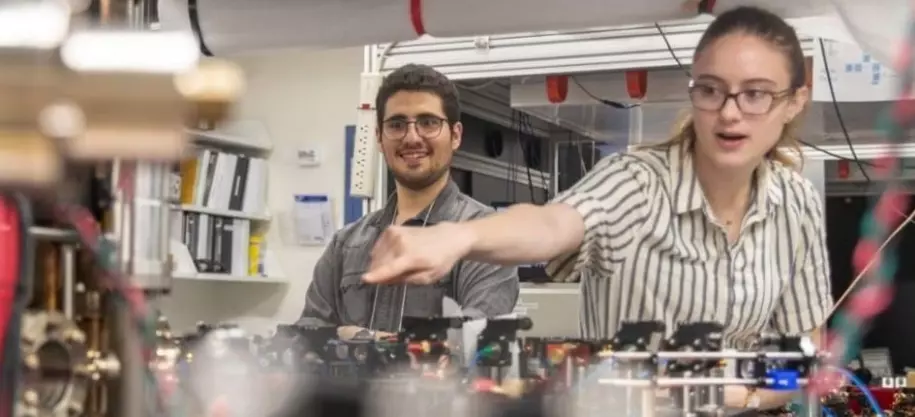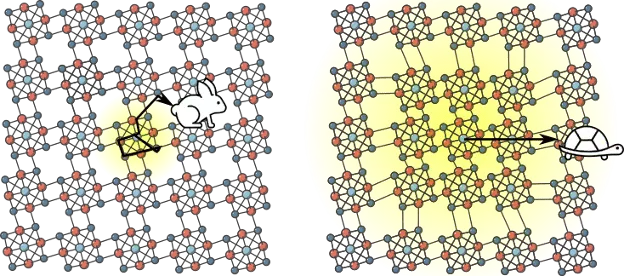Semiconductors — materials that hover in the middle ground between conductors like metals and insulators like glass — underpin all our modern electronics. Mostly made of silicon, these semiconductors comprise the memory modules, microprocessors, and other chips found in virtually all electronic devices from smartphones to toasters. But they’re not perfect.
All semiconductors have quantum speed bumps, which cause them to lose energy as heat. However, researchers at Columbia University have found a new superatomic semiconductor that is more efficient than anything that came before it. In experiments, this semiconductor carried quasiparticles twice as fast as electrons would move through silicon, making it the fastest semiconductor in the world.

Researchers in one of Columbia University's quantum labs.
A Speedy Breakthrough
Every material, down to its atomic structure, vibrates. These vibrations spawn quantum particles known as phonons. Now, here’s where things get tricky. These phonons cause the energy-carrying particles in our devices to scatter, slowing down information transfer. Yet a superatomic semiconductor called Re6Se8Cl2 doesn’t play by these rules.
Unlike in typical materials, where energy particles scatter upon meeting phonons, in Re6Se8Cl2, they bind together. This union forms unique quasiparticles, known as acoustic exciton-polarons. These aren’t just your everyday particles; they can move without scattering, potentially heralding faster and more efficient devices.
Not only did the quasiparticles zip through Re6Se8Cl2 at speeds double that of electrons in silicon, but they also covered vast distances. And instead of electricity, these quasiparticles were controlled by light, which means that devices based on this setup could theoretically cycle at the femtosecond scale — six orders of magnitude faster than the nanosecond achievable in current Gigahertz chips. All of this is achievable at room temperature to boot.
“In terms of energy transport, Re6Se8Cl2 stands out as the best semiconductor we’ve identified,” remarks Professor Milan Delor of Columbia University.
The tortoise and the hare of semiconductors

The difference between the superatomic semiconductor and silicon is similar to the fable of the tortoise and the hare. Credit: Jack Tulyag, Columbia University.
The journey of Re6Se8Cl2 began in the lab of Dr. Xavier Roy from Columbia University’s Department of Chemistry, where they specialize in crafting superatoms. These are clusters of atoms that act as one, often with properties distinct from their constituent elements. Re6Se8Cl2 is made of rhenium (Re), selenium (Se), and chlorine (Cl) atoms.
When Jack Tulyag, a PhD student in the Milan Lab, first brought it to everyone’s attention, the goal wasn’t to find a groundbreaking semiconductor. Rather, the aim was to test their fancy new microscope’s resolution on this material. The superatom looked complex enough for the job. But the results stunned them. Instead of sluggish movement, they witnessed unprecedented speed.
Explaining this phenomenon, Delor draws a parallel with the fable of the tortoise and the hare. Silicon’s allure lies in its fast-moving electrons. But they scatter, much like the hasty hare, who ends up not covering much ground. Contrast this with the excitons in Re6Se8Cl2. They’re slow, but they merge with similarly slow-moving phonons. Like the proverbial tortoise, these resulting quasiparticles advance slowly but steadily. Ultimately, the superatom facilitates faster movement than electrons in silicon.
The Hunt Goes On
While Re6Se8Cl2‘s potential is exciting, there’s a catch. The element Rhenium, a key component, is among the rarest on our planet, making it a pricey choice. In all likelihood, this kind of superatom will never make its way into everyday gadgets. But the discovery has opened many doors. With newfound theories and imaging techniques, the team is eager to unearth other superatomic materials that might even outpace Re6Se8Cl2, perhaps one that incorporates more readily available chemical elements.
“This is the only material that anyone has seen sustained room-temperature ballistic exciton transport in. But we can now start to predict what other materials might be capable of this behavior that we just haven’t considered before,” said Delor. “There is a whole family of superatomic and other 2D semiconductor materials out there with properties favorable for acoustic polaron formation.”
The findings appeared in the journal Science.
▼▼▼
Kyoden Delists, Concludes Final Trading with Market Cap Exceeding $220 Million
Government Backing: Calumet Electronics to Build Substrate Manufacturing Facility in MI
Explosive Report: Huawei Chip Allegedly Produced Using ASML Machine!
Kokusai Electric Stock Jumps After Japan's Biggest IPO Since 2018
......
Read more latest news about the PCB and semiconductor industry here
+86 191 9627 2716
+86 181 7379 0595
8:30 a.m. to 5:30 p.m., Monday to Friday
